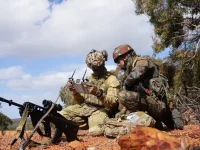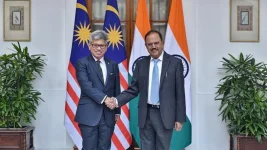- Views: 1K
- Replies: 7

India is rapidly advancing its military capabilities with a focus on small, Artificial Intelligence (AI)-powered drones designed to target individual enemy soldiers, conduct coordinated swarm attacks, and perform precision kamikaze strikes.
This strategic shift, prominently showcased at Aero India 2025 held in Bengaluru, represents a significant evolution in modern warfare, particularly in the context of potential conflicts along the Line of Control (LoC).
The Indian Army's focus on micro-drones contrasts sharply with Pakistan's current reliance on larger, medium-altitude long-endurance (MALE) unmanned aerial vehicles (UAVs).
While Pakistan's arsenal, including the Chinese Wing Loong II and CH-4, and the Turkish Bayraktar TB2, is effective for surveillance and strikes on fixed targets, these platforms are less capable of engaging individual soldiers in close-quarters combat. India's approach aims to leverage advanced technology to neutralize threats at the most granular level.
Several indigenous UAV systems were highlighted at the airshow, demonstrating a blend of autonomy, AI, and soldier-centric design. Key innovations include:
- MBC2 Swarm Drone System: Developed by NewSpace Research & Technologies, these palm-sized drones (under 2 kg) can operate in coordinated groups of up to 50 units. Equipped with AI-driven target recognition and explosive payloads, they can neutralize individual soldiers from 50-100 meters. Live demonstrations at Aero India showcased their autonomous "hunter-killer" capability.
- Autonomous Multi-Mode Amphibious Drone: This versatile platform, a collaboration between DRDO (Defence Research and Development Organisation) and a private startup, can operate on land, water, and in the air. It provides real-time intelligence, surveillance, and reconnaissance (ISR) feeds to ground troops and can execute kamikaze strikes on identified enemy soldiers using thermal imaging.
- TEN AI Weapon System (TAIWS): Presented by Adani Defence, TAIWS integrates a nano-UAV with an AI-powered battlefield control system. This hand-launched drone uses facial recognition and motion tracking to target individual soldiers up to 300 meters away, delivering a 500-gram explosive charge. It is designed to be resistant to electronic jamming.
- Loitering Munitions ("Vyom Kavach Lite"): Zen Technologies showcased its "Vyom Kavach Lite," a soldier-portable UAV system weighing just 3 kg. These drones can loiter for 30 minutes, identify infantry targets using high-resolution optics and AI, and then perform a high-speed (100 km/h) kamikaze attack with a shaped charge effective against body armor.
Along the LoC, where skirmishes often involve small units in challenging terrain, India's micro-UAVs could directly target individual Pakistani soldiers, circumventing radar systems designed for larger aircraft.
Simulations conducted at Aero India 2025 highlighted this potential asymmetry. A mock LoC encounter demonstrated how Indian micro-drones could effectively neutralize a platoon-sized Pakistani force, while a simulated strike by a larger Pakistani UAV was ineffective against dispersed Indian infantry.
India's advancements in drone technology align with the "Aatmanirbhar Bharat" initiative, with over 80% indigenous content in these systems. Indian companies like NewSpace, Adani Defence, and Zen Technologies, supported by initiatives like iDEX (Innovations for Defence Excellence), are driving this technological push. The Indian Army's roadmap reportedly includes plans to induct 5,000 such micro-UAVs by 2030.
The Indian Air Force (IAF) also operates larger UAVs, such as the recently approved acquisition of 31 MQ-9B Predator drones from the United States, according to a Feb 2024 report by the US Defense Security Cooperation Agency.
This layered approach, combining both large and small UAVs, creates a more comprehensive and adaptable aerial strategy. This contrasts with Pakistan's reliance on its approximately 200 MALE UAVs, offering a more complex challenge to Pakistan's current military doctrine.


